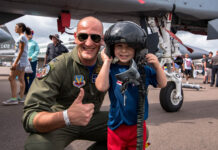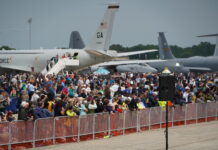There are events that etch themselves into our memories…profound moments that impact our lives in transformative ways and stick with us long after the moment is gone. I can recall vivid details of listening to the radio with my brothers during the announcement of Gulf War. I remember everything about September 11th, 2001. I remember the roar of Galloping Ghost as it flew out of control overhead in September of 2011, and the shock and confusion in the moments and hours after the crash.
Every one of these events has had a lasting impact on the course of not only my life, but the lives of every other person that shares those memories. Following those types of events, we all find ourselves thinking that, “nothing will ever be the same again.” The most recent event that had this effect on me happened on May 4th, 2014.
It was a Sunday evening and I had just arrived back at my home in Virginia after a weekend trip to Indiana. I was on my way to pick up dinner when my phone rang. My heart dropped a bit when I saw that it was John Cudahy. There are few things more gut-wrenching than to get a phone call from the ICAS president in the afternoon on the weekend during air show season; those calls almost never bring good news.
“Dan, Eddie Andreini had an accident in California. Details are still unclear, but it looks like he crashed during an inverted ribbon cut. The CFR took a long time to respond.”
The CFR took a long time to respond…
During the last decade, few events have had as large an impact on our industry as this accident.
In the coming days, it became clear that the response time of the CFR unit was nearly 5 minutes. The National Fire Protection Association (NFPA) standard at that time was for Aircraft Rescue and Fire Fighting (ARFF) to reach a downed aircraft in 3 minutes or less. Since the accident, ICAS has developed a 60-second standard for CFR response. This standard has been adopted by the FAA and all military services that conduct air shows. ICAS has worked with NFPA to reduce their standard to 60 seconds.
This standard is important and can save lives, but how does a show know if it is complying? An emergency response plan is a very useful document, but even the best plans cannot account for every variable at a show. There is great value in tabletop exercises, but even they miss small details. Small details that can sometimes be very important. A pothole in a taxiway. A lost child wandering onto a taxiway. Less-than-crystal-clear communications between air boss and fire chief or between fire chief and tower. Or any of a myriad of variables introduced by putting 30,000 spectators onto a location that can only be tested by running through an emergency. And the only way to ensure that an emergency plan is worthwhile is by putting it to the test with an unannounced drill on practice day.
What is a drill?
Before a discussion on the necessity of an emergency response drill at every air show, we must define what a drill is. There is a wide variety of things that can correctly be called a drill in the air show industry: active shooter drills, inclement weather drills, mass casualty drills and so on. The only type of drill that I want to talk about in this column is the emergency response drill.
The emergency response drill is the simulated response to a performer accident in the air show display area. For an emergency response drill to be effective, it is critical that the element of surprise is maintained. To truly test the responsiveness of the CFR personnel, they cannot be aware that a drill is coming. If there is a pre-drill warning, it is possible that the crews respond differently than they would in an actual emergency. The sudden surge of adrenaline impacts each person in different ways, and for the integrity of the drill, it is ideal that the responders are managing the same type of adrenaline surge that they would experience in a real emergency.
There are some stylistic differences in how to begin a drill from one show to the next.
“I never tell anyone on the ground when I’m going to do a drill,” says one air boss. “I will ask a performer to take some extra gas, and after they finish their practice, I get some smoke going on the field and simulate the full response. It is important to make sure that no one from CFR hears the word ‘drill’ over the radio. I want them completely surprised.”
Another air boss takes a more nuanced approach. “You have to read the environment when running a drill. I like to start a drill when there’s a lot of action on the field, so I will have to make a couple discrete calls to taxiing aircraft or a control tower just to give them a bit of warning so that we don’t create a real emergency while simulating one. The drill is good to test the response of the CFR, but it is also helpful to gauge what other performers will do if there’s an emergency while they’re taxiing or performing.”
Both options are reasonable and can be utilized at a show, but no matter the option, the drill MUST be done!
Why conduct a drill?
ICAS has actively encouraged air shows to conduct drills for at least a decade. But why? Why go through the hassle of a drill when you have trained professionals on standby ready to go at a moment’s notice? And what is the purpose of a drill if the show has already done an extensive table top emergency response exercise within a few weeks of the show? Let’s look a little closer.
- You can learn a lot from your drills. Running a drill allows all parties to run through the communication nets and it will often identify bottlenecks and hang ups that the tabletop exercises may miss. You can learn the difference between simply arriving to a point on the airport and arriving on that point ready to apply extinguishant and/or begin extraction procedures. You will learn to avoid confusion between different vehicles responding to the same incident. You may discover that the radio communications that seemed so straightforward in the table top exercise did not work as planned during the drill. The CFR personnel will experience the rules of engagement during air show operations and how they may differ from those that they are more familiar with during normal/standard airport operations.
- Drills cost next to nothing to run. The CFR personnel and equipment are already on site. The performers are already practicing. And the practice day is a full mockup of a show day. There is no additional cost incurred by running a drill on a practice/rehearsal day. Many ARFF units can count the drill toward training and proficiency, so there is no downside to running the drill. No downside.
- Drills sets your performers’ minds at ease. I recently spoke to a performer that expressed shock when he arrived at a show and discovered that there would not be a practice day drill. “I am always leery of shows that don’t do drills, not because I think they are underprepared, but because I worry more about what could happen if I experience an emergency during my act.” The industry has gone to great lengths to help put the performers’ minds at ease as they prepare to perform low-level aerobatics. For example, the industry created the “Sacred 60 Minutes” to ensure that performers have sufficient “quiet time” to prepare for their performance. By not running a practice drill, a show creates uncertainty and questions for the performers that may distract or concern them at a time when they should be completely focused on executing their performance sequence safely. They may not say it out loud to you because you sign their paycheck, but they want and expect you to schedule and conduct those Friday emergency response drills.
- Drills on practice days are the industry standard. ICAS has worked closely with federal agencies, the armed services, industry organizations and the air show community to make emergency response a bedrock to an air show’s safety planning and preparation. Most air shows in North America run emergency response drills, and FAA air show policy requires it. In the event that a show has an emergency, whether or not the show conducted a drill will be one of the first questions a lawyer or insurance company will ask. They may even reference this article in the ICAS magazine and ask why you and your show opted to ignore this FAA requirement and industry standard.
- Drills improve your response to actual emergencies. As any air show professional knows, the debrief is the crown jewel to improving any aspect of the industry. Being able to make improvements based on performance is the hallmark of a successful show, and it is no different for an emergency response drill. Finding the gopher holes—literally or figuratively—in your emergency response will allow you to perfect your plan and avoid those traps in an actual emergency.
- There is no reason to NOT conduct a drill. Worst case, you discover that your emergency response is every bit as good as you thought it was. No hiccups. No delays. Near perfect execution. Best case: you discover an oversight or a mistake or an incorrect assumption that you have a chance to correct during rehearsal day rather than during a real emergency some other time during the weekend.
Drills are NOT optional!
ICAS has worked very hard to improve the CFR response to emergencies at air shows. We have changed our internal best practices. We have collected helpful emergency extraction information from most of our pilots and made it easily accessible to event organizers and first responders. We have led the charge to change the way the Navy, Air Force and Marine Corps treat air show incidents. We are standing up a new committee to directly engage on these issues. We have worked with the FAA to mandate the collection of extraction documentation and the running of practice day drills. The following excerpt is new language that was added into FAA air show policy at the behest of ICAS:
The event organizer, air boss, and emergency response personnel must conduct an emergency response exercise (drill or full-scale) on the event’s practice/rehearsal day. This exercise should identify any weaknesses or deficiencies in plans and capabilities and give personnel the opportunity to clarify responsibilities, assignments, and procedures.
May 4th, 2014 can serve as a lesson for all of us. It has been engraved into my memory and has motivated my effort to move the needle on air show safety for the last five years. There is no longer any fig leaf to hide behind with emergency drills. Let’s get everyone on the team. It comes down to one simple fact: running drills can save lives.








